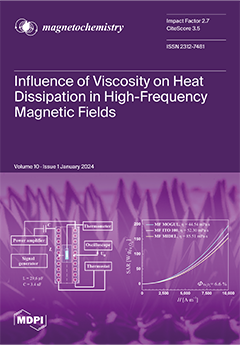The magnetic permeability (
μ), dielectric permittivity (
ε) and electrical conductivity (
σ) of six elastomer samples obtained by mixing silicone rubber (RTV-530) with a kerosene-based ferrofluid in different volume fractions (
φ), 1.31%, 2.59% and 3.84%, were
[...] Read more.
The magnetic permeability (
μ), dielectric permittivity (
ε) and electrical conductivity (
σ) of six elastomer samples obtained by mixing silicone rubber (RTV-530) with a kerosene-based ferrofluid in different volume fractions (
φ), 1.31%, 2.59% and 3.84%, were determined using complex impedance measurements over a frequency range of
500 Hz–
2 MHz. Three samples (A
0, B
0 and C
0) were manufactured in the absence of a magnetic field, and the other three samples (A
h, B
h and C
h) were manufactured in the presence of a magnetic field,
H = 43 kA/m. The component
μ″ of the complex effective magnetic permeability of all samples presents a maximum at a frequency,
fmax, that moves to higher values by increasing
φ, with this maximum being attributed to Brownian relaxation processes. The conductivity spectrum,
σ (f), of all samples follows the Jonscher universal law, which allows for both the determination of the static conductivity,
σDC, and the barrier energy of the electrical conduction process,
Wm. For the same
φ,
Wm is lower, and
σDC is higher in the samples A
h, B
h and C
h than in the samples A
0, B
0 and C
0. The performed study is useful in manufacturing elastomers with predetermined properties and for possible applications such as magneto-dielectric flexible electronic devices, which can be controlled by the volume fraction of particles or by an external magnetic field.
Full article





